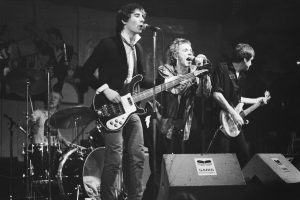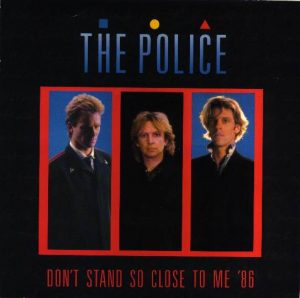 It seems that every year that ends with a “…6” has an example from the music world of great social media marketing – even before the invention of “social media marketing”.
It seems that every year that ends with a “…6” has an example from the music world of great social media marketing – even before the invention of “social media marketing”.
1966

The Beatles’ 1966 album Revolver. © 1966 EMI/Parlophone
The Summer of 1966 may be fondly remembered by some for England finally winning the World Cup. But it also marks the release of a Beatles record, often described as one of the best albums ever recorded. They had built a huge following in the preceding six years, honing their skills in front of live audiences from Liverpool to Hamburg. Then releasing two albums a year in ’63, ’64 and ’65. Their communication channel was their music; the feedback was their audiences’ reactions. This was real “audience engagement”, 60s-style. By 1966 they had perfected their art, built their tribe, established their supremacy and delivered “Revolver”, a work of stunning genius. Years of engaging, growing and influencing an audience enabled The Beatles to create a brilliant piece of work – and for it to sell 1.1m units in five months in the US alone. The Beatles clearly knew how social media worked before it was invented.
1976

The Sex Pistols
Ten years later, in the Summer of 1976, another band achieved success – and notoriety – by taking almost precisely the opposite route. In July 1976 the Sex Pistols premiered a song, the clattering, raw, nihilistic “Anarchy in the UK”. Later that year they recorded it, released it and promoted it by – among other things – drunkenly swearing on live television, causing a storm of protest, newspaper column inches and, of course, interest. The Sex Pistols achieved huge sales for their first – and only – UK-released studio album, “Never Mind the Bollocks, Here’s the Sex Pistols”, by going about social media, 1970s style: creating something to shout about, shouting about it and getting others to shout louder.
1986

The Police singleDon’t Stand So Close to Me ’86. © 1986 A&M
In the Summer of 1986, another UK band, The Police, provided a version of efficient social media content marketing – re-purposing previously used original content. The group had been together for nearly a decade and, in that time had become one of the highest-selling bands in the world. In June 1986 they re-entered the studio to record a new album. But the drummer, Stewart Copeland, broke his shoulder in a polo accident, meaning plans for new material were scuppered. So they simply re-worked the 1980 hit and Grammy Award winning “Don’t Stand So Close to Me” – itself an homage to Vladimir Nabokov’s Lolita. The new recording – with a programmed drum track, instead of Copeland playing a traditional kit – was released as “Don’t Stand So Close to Me 86″. It instantly became a hit in the UK, US, Australia, New Zealand and across Europe. All without having to write or record a new song. And it was used to promote a compilation album, released the same year. Alongside VHS, Betamax and Laserdisc video versions. So a single, an album and three video releases without having to write new songs. This is brilliantly efficient re-purposing of social content, 1980s-style.
1996

The Oasis 1996 box set Definitely Maybe © 1996 Oasis
The Police may have demonstrated how to benefit from repurposed content in 1986, but ten years later, Oasis took the idea several stages further. By 1996, Oasis had released the successful “Definitely, Maybe” album (15m sales) and the even bigger-selling “(What’s the Story) Morning Glory?” (22.4m) in the previous two years. A great deal of 1996 was taken up with live gigs, including two successive nights at Manchester City’s then football ground Maine Road; another two successive nights in front of 125,000 fans each night at Knebworth; an “Unplugged” gig at the Royal Albert Hall; and an arena tour of north America. This left them little time to record and release new material. So, in the 1996 version of creatively repurposing content, they released two compilation box sets of singles, B sides and interviews. This gave their audience valuable material: the key essence of social media, 1990s style.
2006

Take That’s 2006 album Beautiful World © 2006 Polydor
In 2006, a four-piece group went into the studio to record what was to become the 35th largest-selling album in UK music history. They could not have done this without spending time and effort nurturing and engaging a following. It was their fourth of – so far – seven studio albums. The first three had sold 870,000, 1.3m and 680,000 units respectively. So, they had a tribe, but it had been starved of new material for eleven years. If they created a mediocre album it would sell; but to sell a lot of units, they had to create an album they knew would work. So, they did the 2006 equivalent of what social media marketers do nowadays: they looked at the formula that had worked for them in the past and repeated it. Each album had ten or eleven songs written by the group’s main songwriter; the group’s members were each given different roles in each track (lead singer, chorus, back-up, harmonies); and they used a number of different producers. So the 2006 album followed suit: the group wrote eleven songs for the album; shared the vocal roles as before; and hired fifteen production staff. “Beautiful World” became the highest-selling Take That album ever, by following social media principles that worked as well ten years ago as they do today: measure what works and repeat it.
For the last five decades – and more – certain principles of marketing have been established, confirmed, tested and have shown to be robust and lucrative.
- Nurture, develop and communicate with your tribe
- Create brilliant, content that you know your audiences loves and values
- Repeat
Some of the biggest names in the music industry have used these steps to sell millions of units. But what is most important is that the same steps can be used in any industry. They’ve worked for more than fifty years – the question is, how are you going to make them work for you in 2016?
Do you want to start applying these simple social media techniques to your business? Do you need help setting up social media accounts? Or do you need a social media plan, to set out what will work best for your business? We can provide expert advice and guidance on social media campaigns to help you maximise returns and start achieving your goals as soon as possible. Email us now – info@thedigitalzebra.com.

